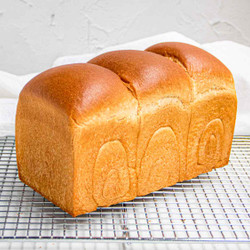For the Scald : In a medium bowl, whisk glutinous rice flour and sugar to combine. Add boiling milk and rapidly whisk until mixture thickens to pudding-like consistency and registers between 155 to 170˚F (68 to 77˚C). (See notes.)
Scatter butter over the scalded rice flour mixture, cover bowl with plastic wrap, and let sit until butter has melted and mixture has cooled to at least 80˚F (27˚C), about 1 hour.
For the Dough : Add milk and egg yolk to the scald mixture. Whisk until well-combined and at or below 75˚F (24˚C); if not at temperature, cover and let sit until it reaches 75ºF.
In the bowl of a stand mixer fitted with the dough hook attachment, combine flour, salt, and yeast, and mix on low speed until well combined, about 15 seconds. Turn off mixer, then add scalded rice flour mixture all at once and mix on low speed until dough is uniform, about 2 minutes, using a flexible spatula to scrape down sides of bowl and dough hook as needed.
Increase speed to medium and mix until dough just starts to come away from sides of bowl, about 8 minutes. (The dough will remain sticky and webby. Do not overmix here; the dough should not be bouncy.)
Using nonstick baking spray, grease a large bowl; the bowl should be big enough for dough to double in size. Transfer dough to the greased bowl, and cover bowl tightly with plastic wrap. Let sit at warm room temperature (75-80˚F; 24-27˚C) until the dough is puffy and expanded by about 1 ½ times its original volume, 60 to 90 minutes.
Using lightly moistened hands, deflate the dough until it is restored to its original volume. Cover tightly and refrigerate until dough is at least 55˚F (13˚C), at least 2 hours and up to 24 hours.
To Bake a Yama ("Mountain") Style Loaf (see notes below for how to adapt this recipe to produce a perfectly square kaku-style loaf): Using nonstick baking spray, grease a 9- by 4- by 4-inch loaf pan. Lightly flour top of dough and transfer to a lightly-floured work surface. Using a knife or dough scraper, divide dough into 3 equal pieces, about 225g each. Gently shape each into a round. Cover loosely with plastic wrap and let sit for 30 minutes.
Working with one ball of dough at a time (seam-side up), lightly flour exterior of dough and, using a rolling pin, flatten and roll each ball into a 5- by 8-inch oval. Fold the long ends into the center to form a 4-inch wide strip. Roll strip into 9- by 4-inch rectangle, flouring dough on both sides as needed to prevent sticking. Starting at the short end, roll dough into a 4-inch-wide log, stretching it gently as you go and keeping the spiraled edges even. Pinch the seam closed, set aside. Repeat with remaining dough balls and place each shaped cylinder of dough into greased loaf pan, side-by-side, seam-side down, and evenly spaced apart. (The spiraled ends should be facing the long side of pan.)
Loosely cover with plastic wrap and let sit at warm room temperature (75 to 80˚F; 24 to 27˚C) until top of loaf is ½ inch below lip of pan, 1 to 2 hours.
Halfway through proofing time, adjust oven rack to middle position and preheat oven to 300ºF (150ºC).
When loaf is ready to bake, transfer loaf to oven. Bake until loaf is well-browned and has an internal temperature of at least 195ºF (88ºC), 50 to 60 minutes.
Transfer the pan to a cooling rack and brush the exposed surface of loaf with butter. (See notes.) Let cool for 5 minutes, then remove loaf from pan and cool on wire rack, to room temperature, at least 1 hour.
